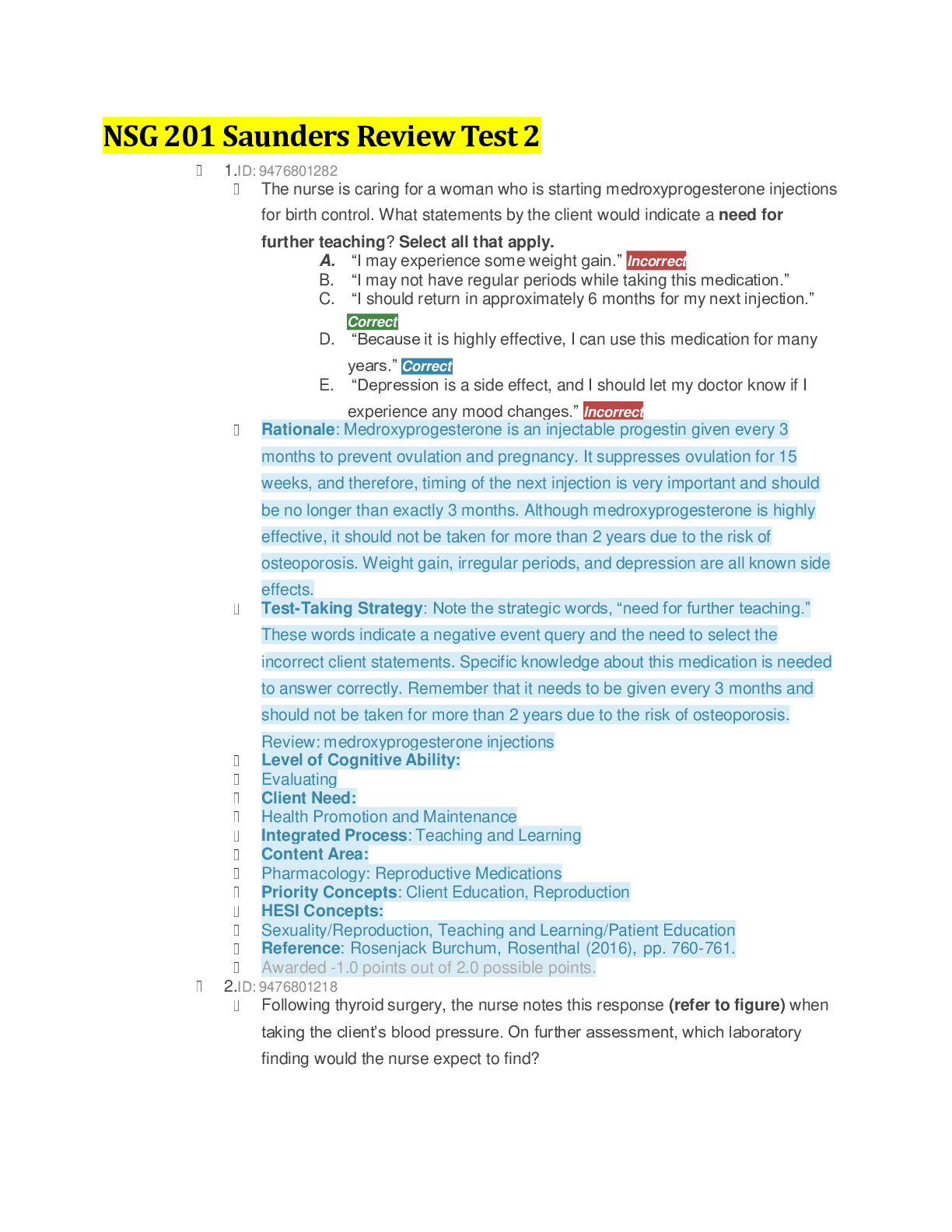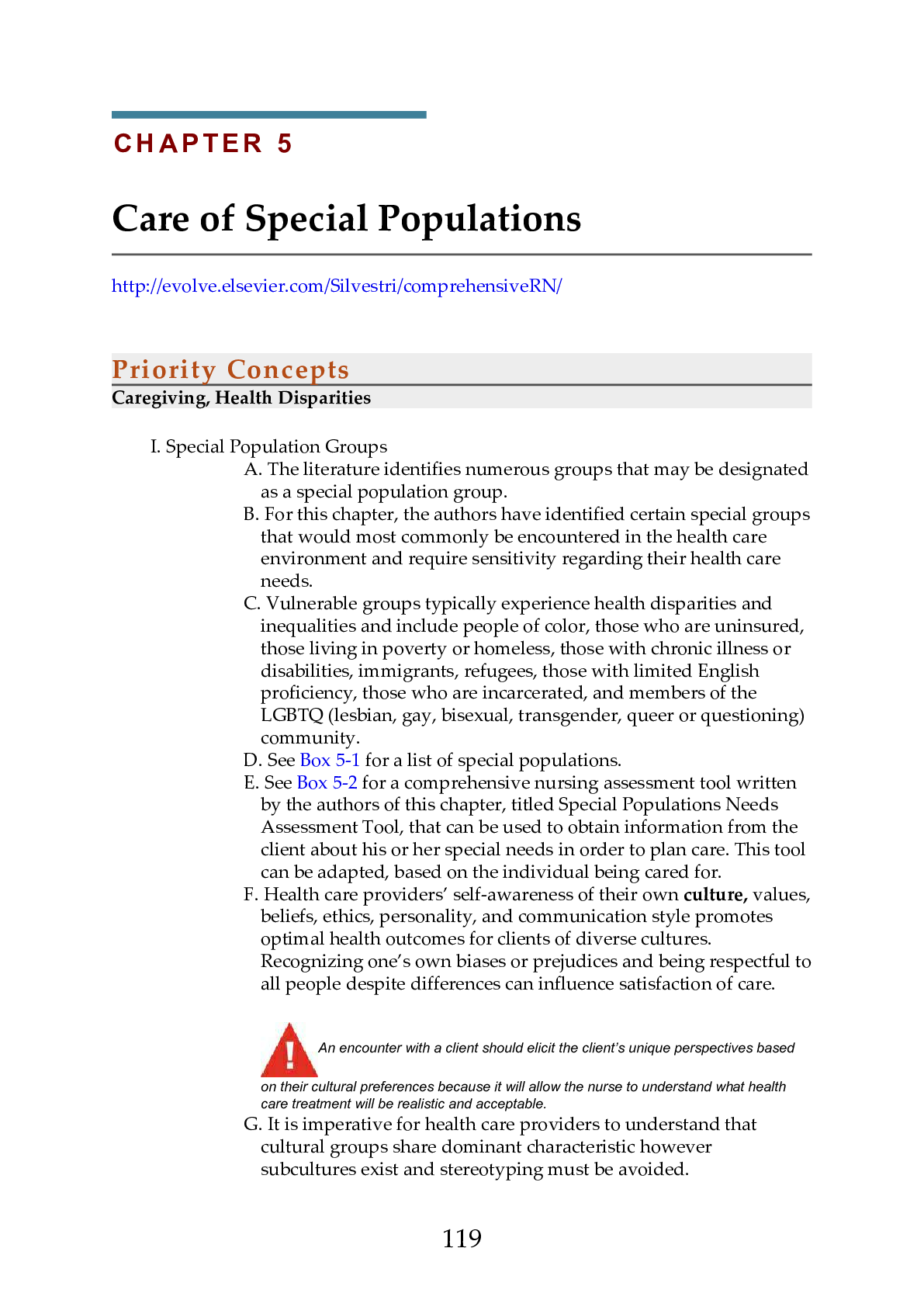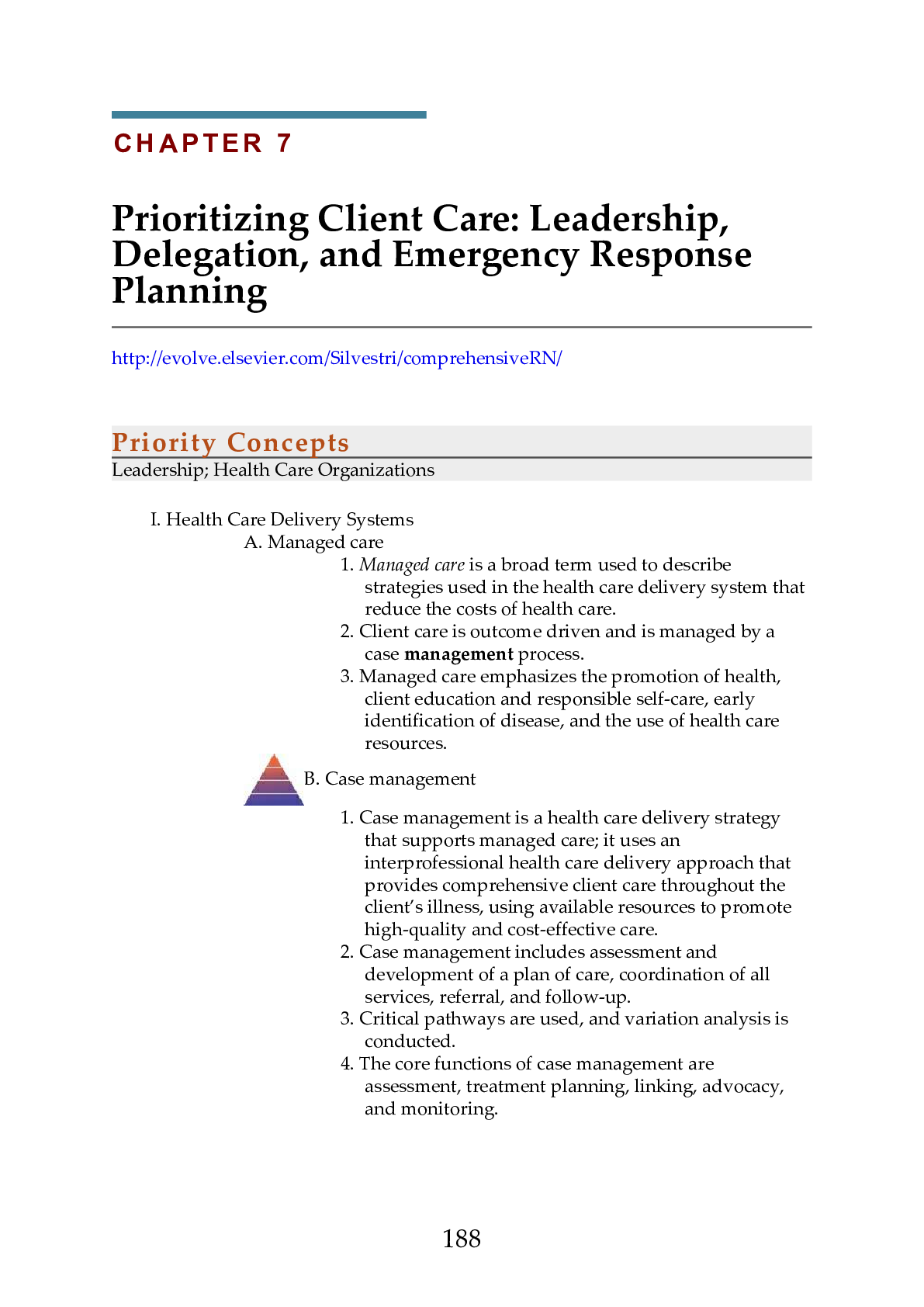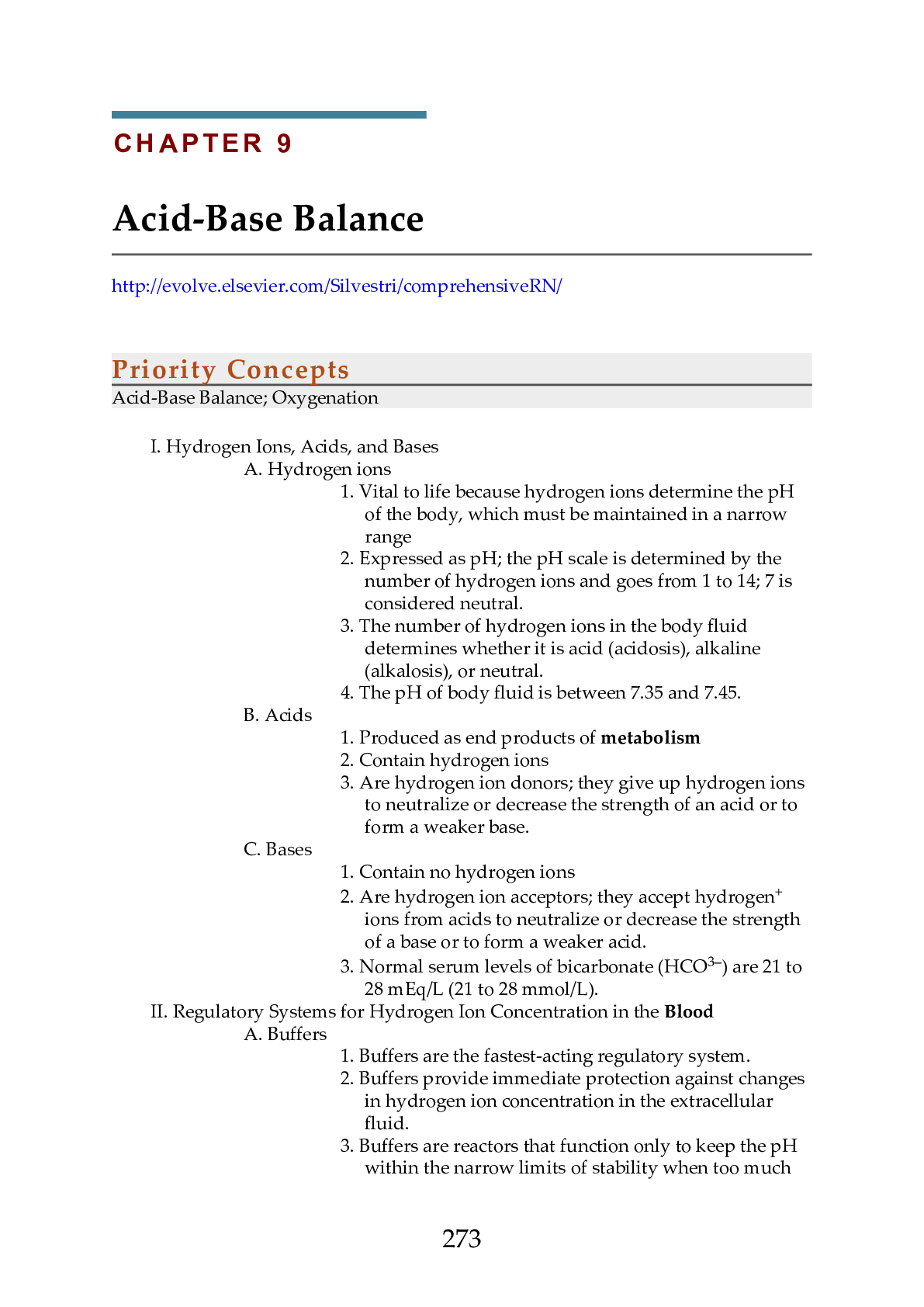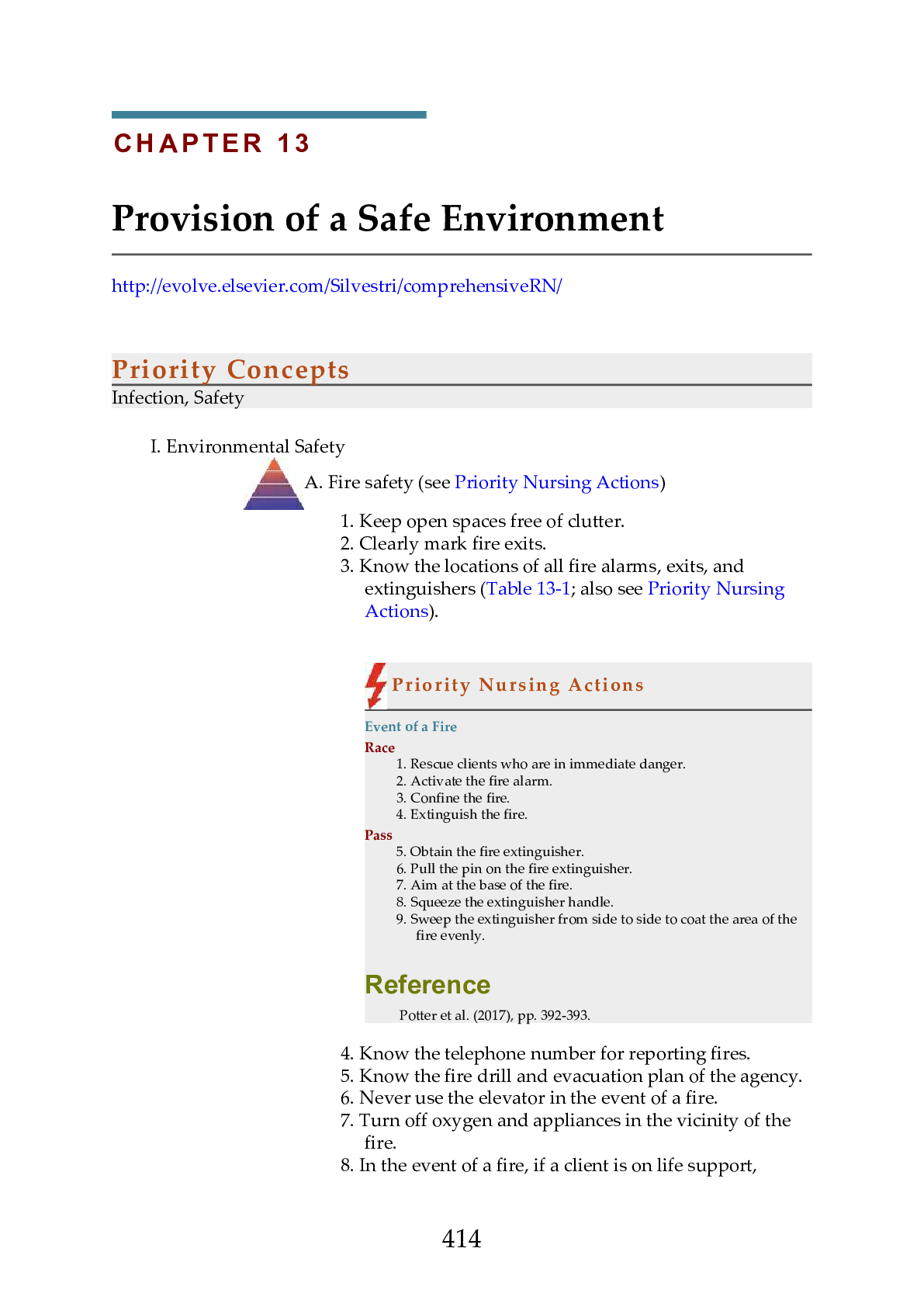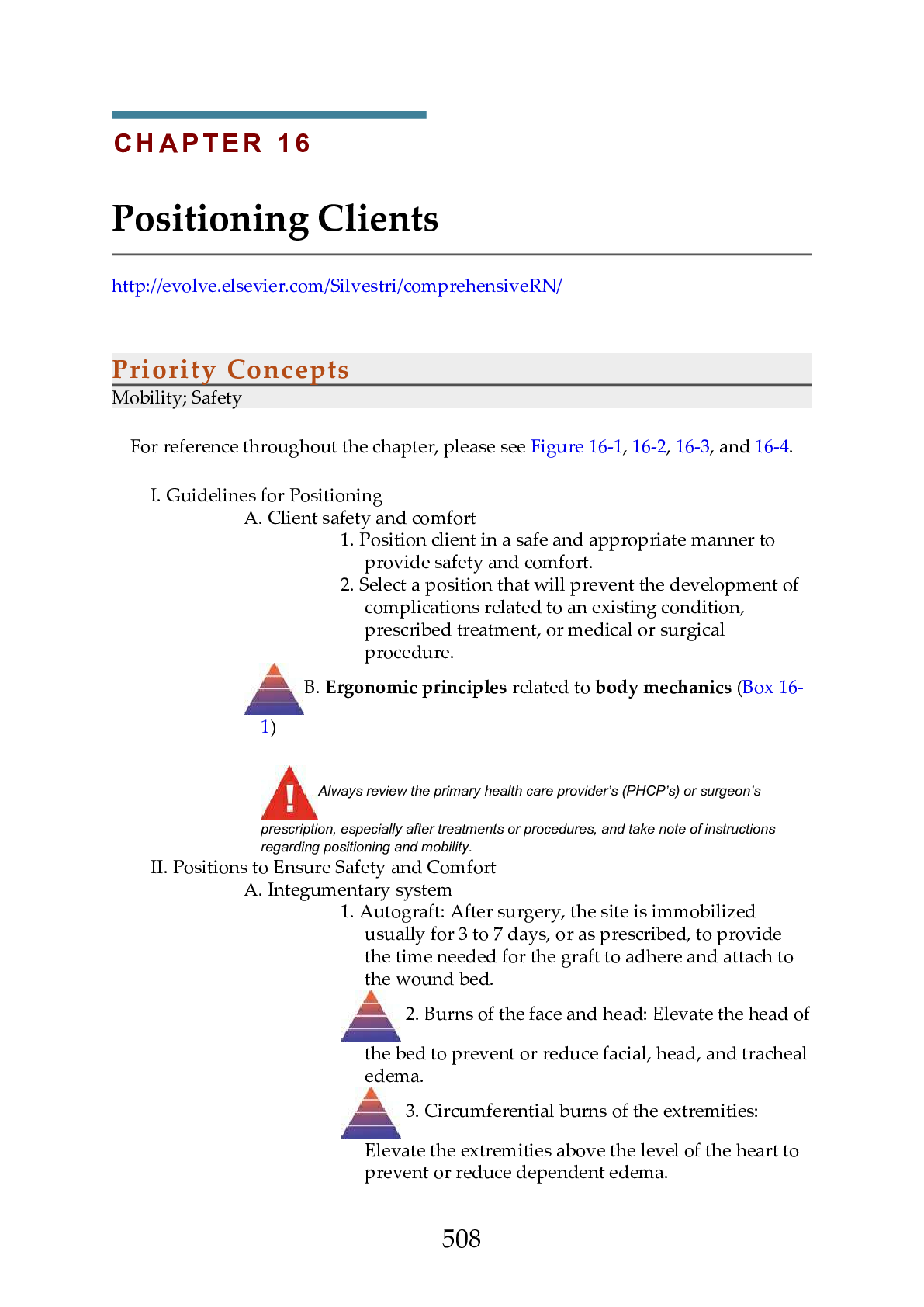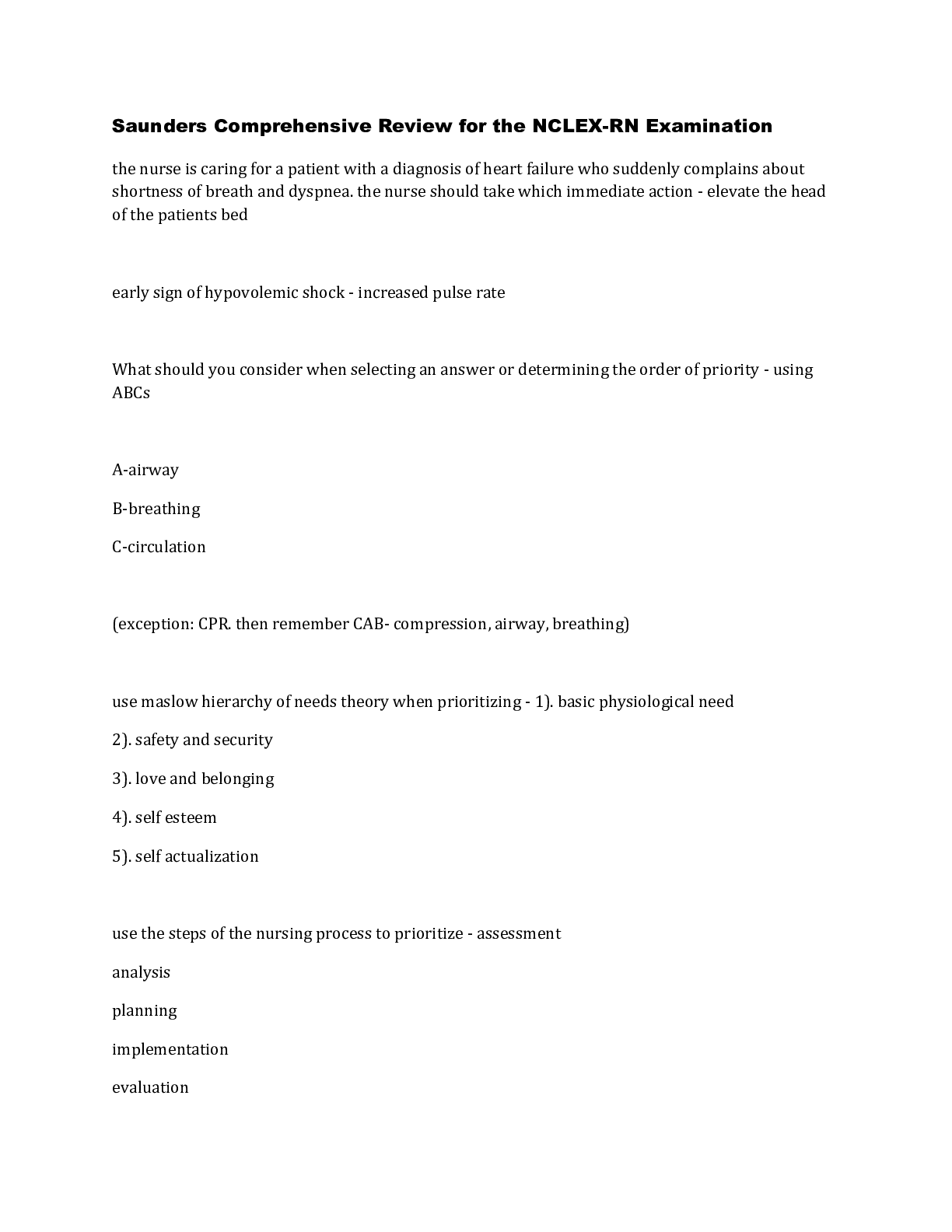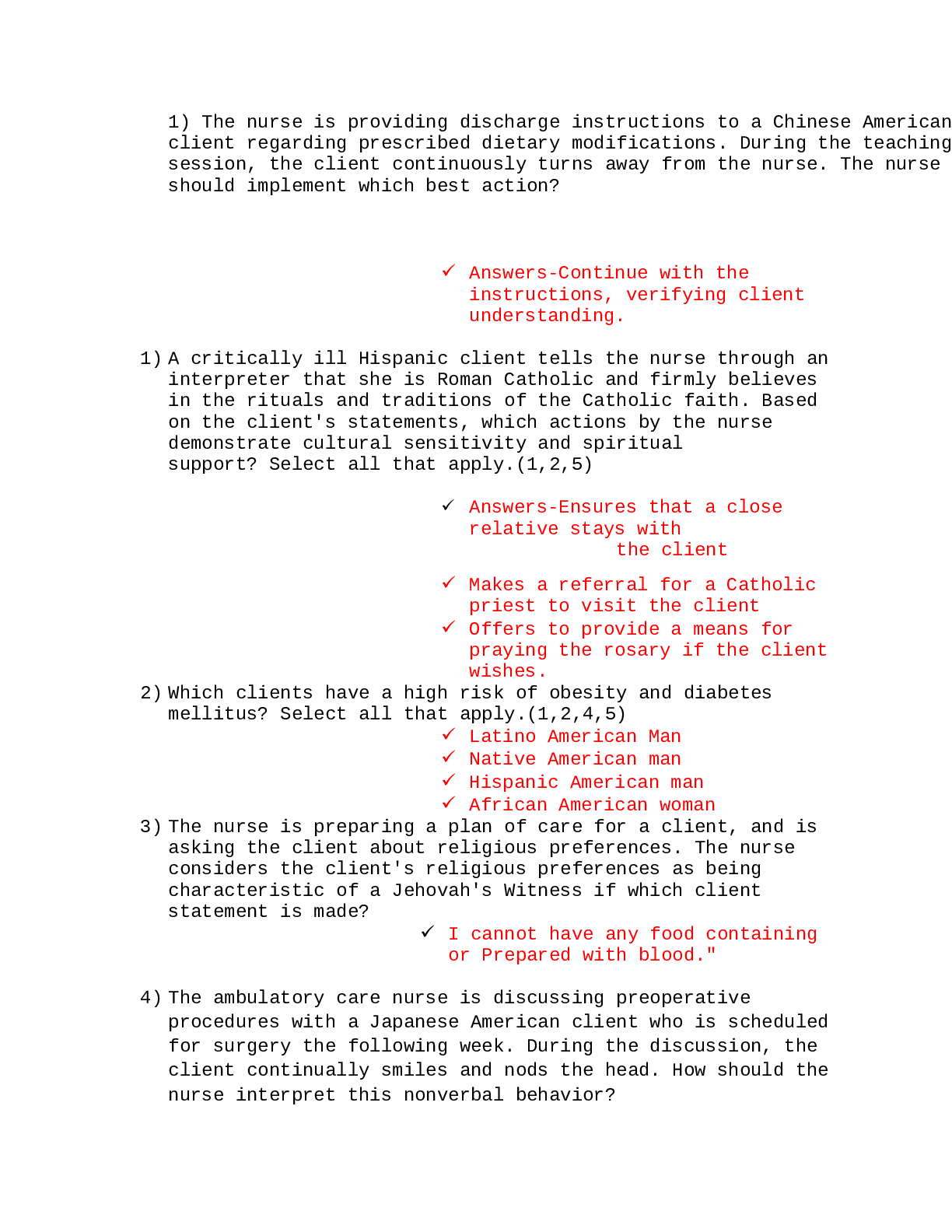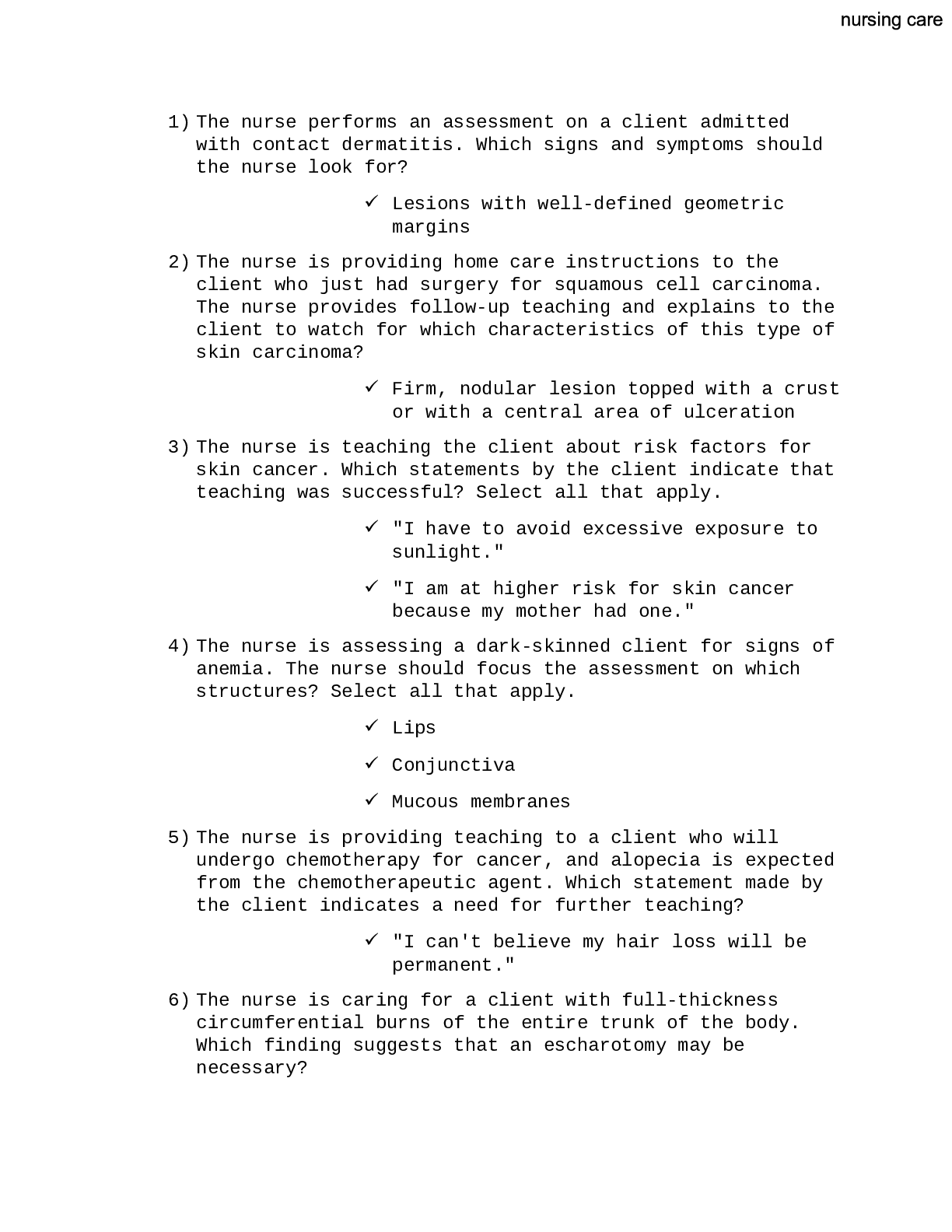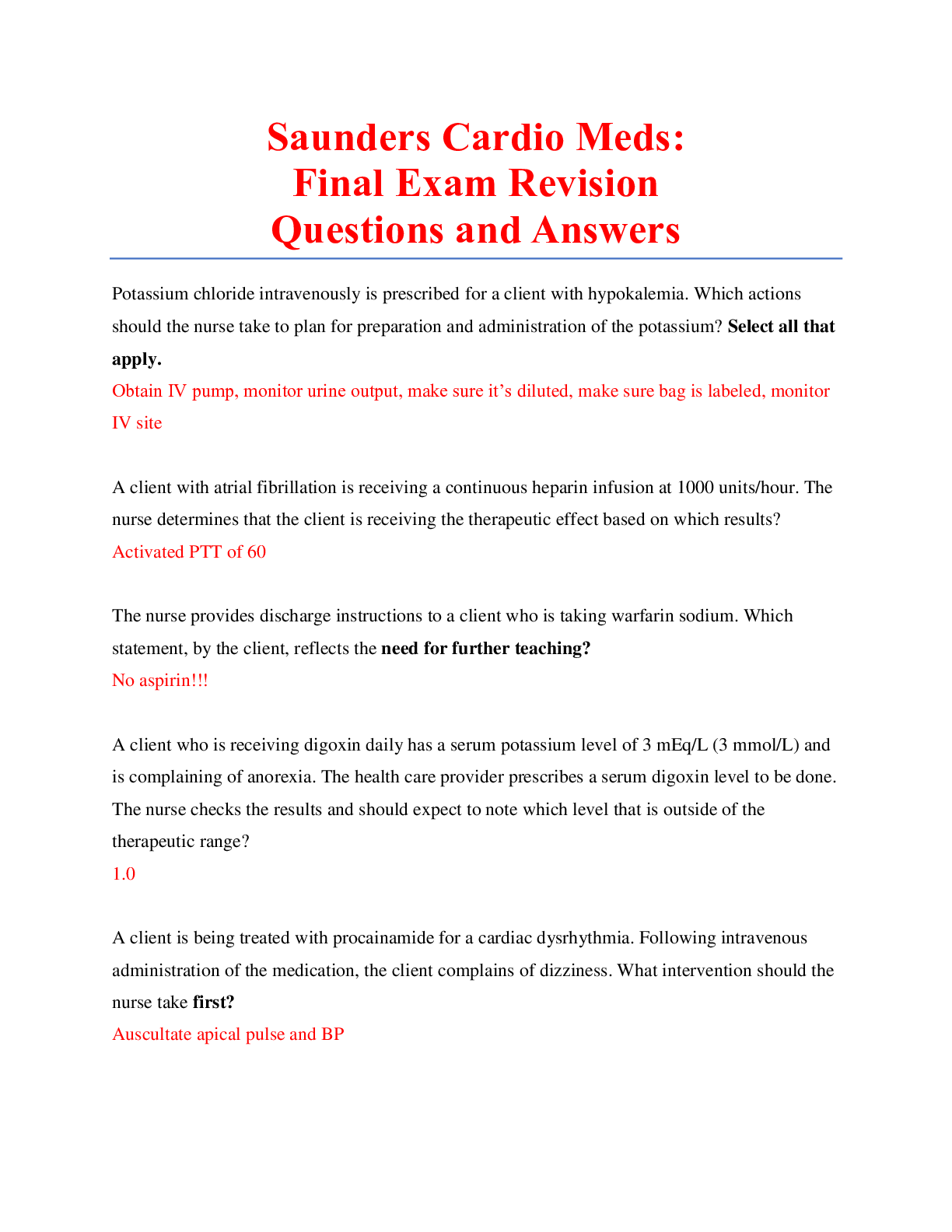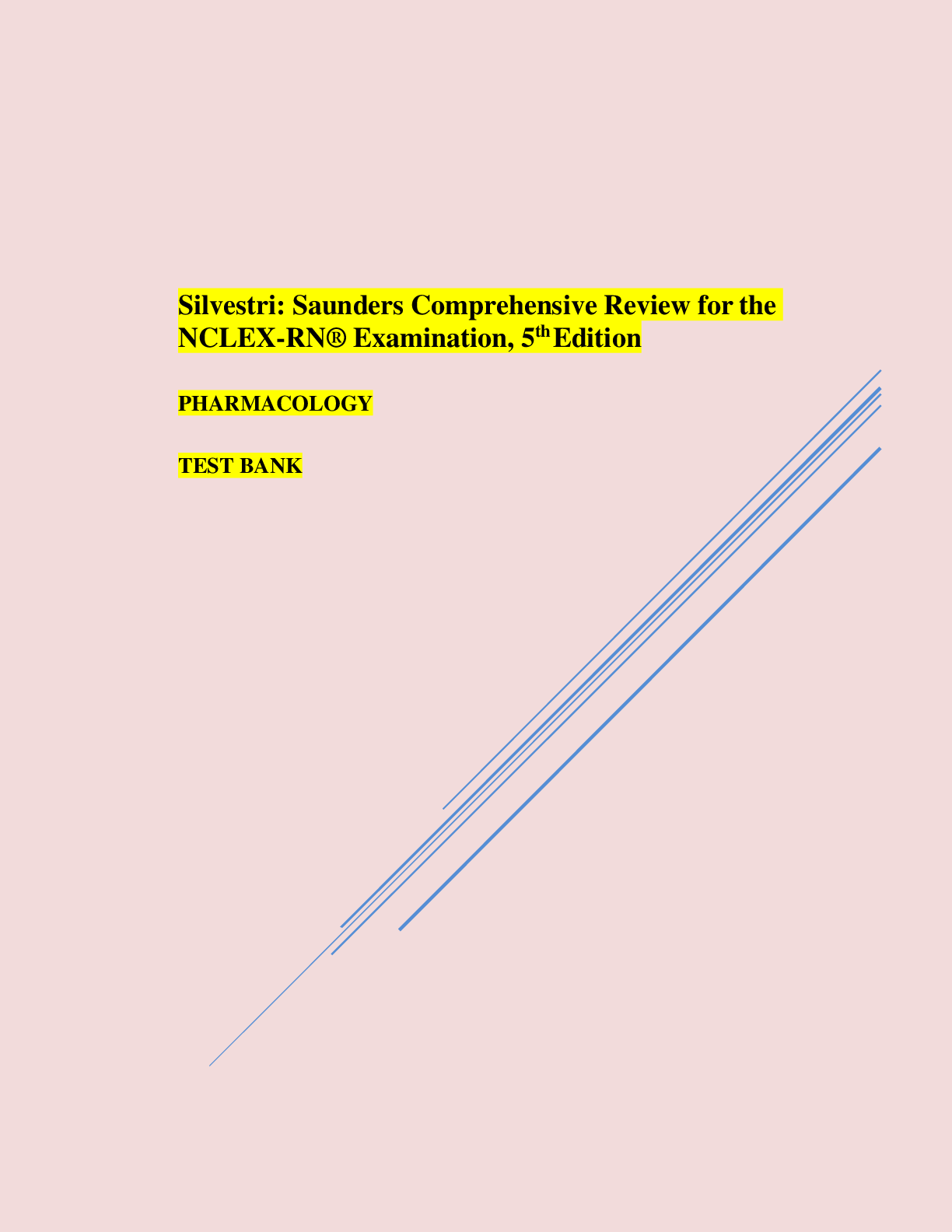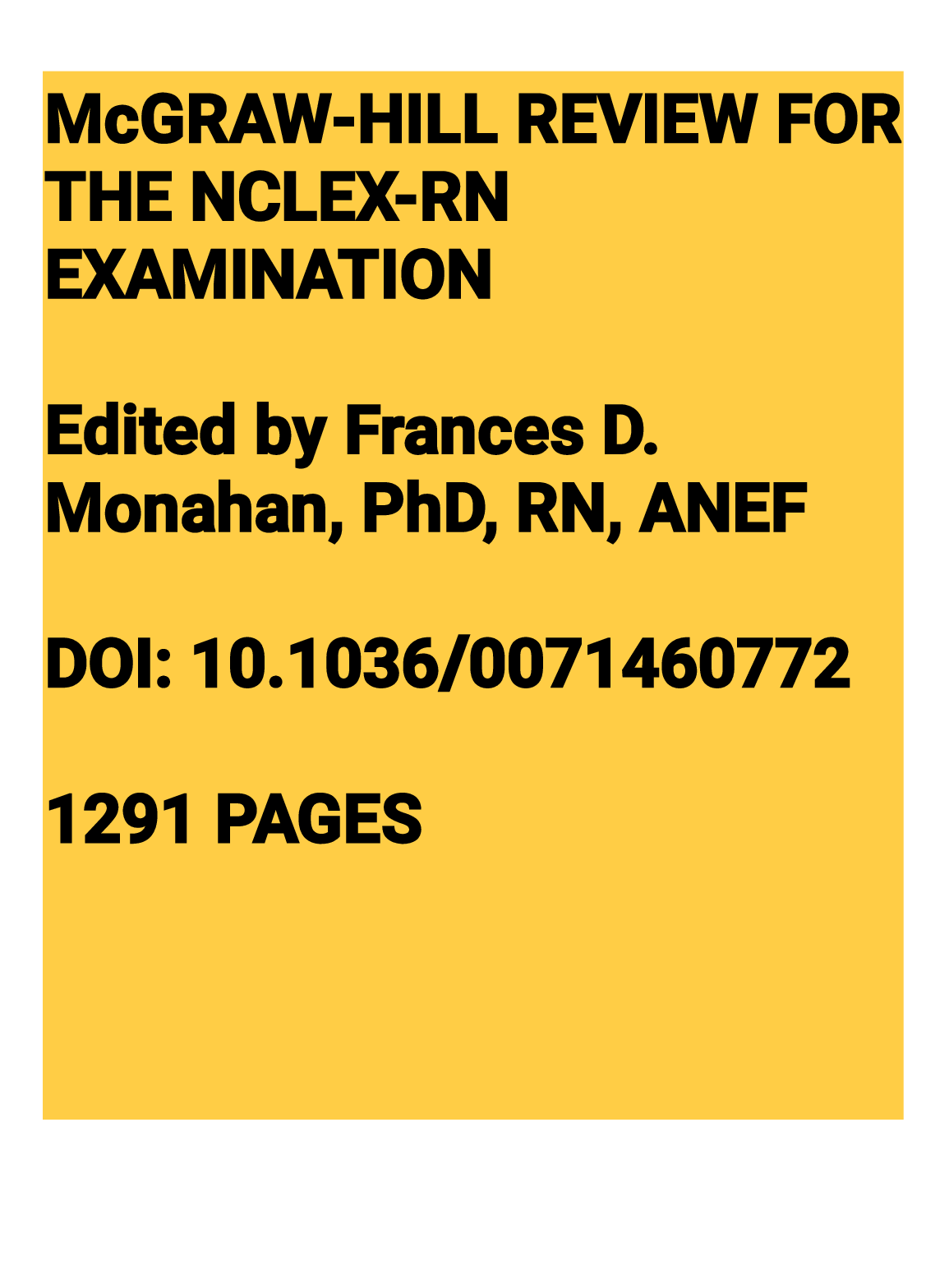*NURSING > NCLEX-RN > C H A P T E R 11 Nutrition: From Saunders Comprehensive Review for the NCLEX-RN Examination 8th Edit (All)
C H A P T E R 11 Nutrition: From Saunders Comprehensive Review for the NCLEX-RN Examination 8th Edition. (Available: https://bit.ly/2HeJuMt ). Contains Practice questions and Answers with the Rationale, Test-Taking Strategy, Level of Cognitive Ability, Client Needs, Integrated Process, Content Area, Health Problem, Priority Concepts and Reference
Document Content and Description Below
Priority Concepts Health Promotion; Nutrition I. Nutrients A. Carbohydrates 1. Carbohydrates are the preferred source of energy. 2. Sugars, starches, and cellulose provide 4 cal/g. 3. Carbohydra... tes promote normal fat metabolism, spare protein, and enhance lower gastrointestinal function. 4. Major food sources of carbohydrates include milk, grains, fruits, and vegetables. 5. Inadequate carbohydrate intake affects metabolism. B. Fats 1. Fats provide a concentrated source and a stored form of energy. 2. Fats protect internal organs and maintain body temperature. 3. Fats enhance absorption of the fat-soluble vitamins. 4. Fats provide 9 cal/g. 5. Inadequate intake of essential fatty acids leads to clinical manifestations of sensitivity to cold, skin lesions, increased risk of infection, and amenorrhea in women. 6. Diets high in fat can lead to obesity and increase the risk of cardiovascular disease and some cancers. C. Proteins 1. Amino acids, which make up proteins, are critical to all aspects of growth and development of body tissues and provide 4 cal/g. 2. Proteins build and repair body tissues, regulate fluid balance, maintain acid-base balance, produce antibodies, provide energy, and produce enzymes 333and hormones. 3. Essential amino acids are required in the diet because the body cannot manufacture them. 4. Complete proteins contain all essential amino acids; incomplete proteins lack some of the essential fatty acids. 5. Inadequate protein can cause protein energy malnutrition and severe wasting of fat and muscle tissue. Major stages of the lifespan with specific nutritional needs are pregnancy, lactation, infancy, childhood, and adolescence. Adults and older adults may experience physiological aging changes, which influence individual nutritional needs. D. Vitamins (Box 11-1) 1. Vitamins facilitate metabolism of proteins, fats, and carbohydrates and act as catalysts for metabolic functions. 2. Vitamins promote life and growth processes and maintain and regulate body functions. 3. Fat-soluble vitamins A, D, E, and K can be stored in the body, so an excess can cause toxicity. 4. The B vitamins and vitamin C are water-soluble vitamins, are not stored in the body, and can be excreted in the urine. E. Minerals and electrolytes (Box 11-2) 1. Minerals are components of hormones, cells, tissues, and bones. 2. Minerals act as catalysts for chemical reactions and enhancers of cell function. 3. Almost all foods contain some form of minerals. 4. A deficiency of minerals can develop in chronically ill or hospitalized clients. 5. Electrolytes play a major role in osmolality and body water regulation, acid-base balance, enzyme reactions, and neuromuscular activity (see Chapter 8 for additional information regarding electrolytes). F. Water 1. Critical for cell function. 2. Makes 60% to 70% of total body weight. 3. A person cannot survive without water for more than a few days. II. Malnutrition Laboratory Markers 334A. Hematological studies and studies evaluating protein balance 1. Complete blood cell count with red blood cell indices and peripheral smear to differentiate between anemias and nutritional deficiencies 2. Long-term protein status can be determined by evaluating serum albumin levels. 3. Short-term protein status is best determined by evaluating retinol-binding protein, prealbumin, transferrin, creatinine, and blood urea nitrogen (BUN) levels. 4. Serum electrolytes (see Chapter 8). 5. Nitrogen balance is evaluated by measuring urea in the urine, which provides information regarding protein loss. Always assess the client’s ability to eat and swallow and promote independence in eating as much as is possible. III. MyPlate (Fig. 11-1) A. Provides a description of a balanced diet that includes grains, vegetables, fruits, dairy products, and protein foods (see http://www.choosemyplate.gov/). B. A nutritionist should be consulted for individualized dietary recommendations (see Box 11-3 for nutrition throughout growth and development). C. Guidelines 1. Avoid eating oversized portions of foods. 2. Fill half of the plate with fruits and vegetables. 3. Vary the type of vegetables and fruits eaten. 4. Select at least half of the grains as whole grains. 5. Ensure that foods from the dairy group are high in calcium. 6. Drink milk that is fat-free or low fat (1%). 7. Eat protein foods that are lean. 8. Select fresh foods over frozen or canned foods. 9. Drink water rather than liquids that contain sugar. Always consider the client’s cultural, spiritual, and personal choices when planning nutritional intake. IV. 2015-2020 Dietary Guidelines for Americans A. Provides average daily consumption guidelines for the five food groups (see https://health.gov/dietaryguidelines/2015/guidelines/). B. Guidelines 1. Maintain healthy body weight. 2. Increase physical activity and decrease sedentary activities. 3353. Limit saturated fats and trans fats, with less than 10% of daily calories from saturated fats. 4. Limit added sugars so that less than 10% of daily calories are from added sugars. 5. Consume less than 2300 milligrams (mg) of sodium per day. 6. Consume low-sodium and potassium-rich foods. 7. Limit alcohol intake to moderate use (one drink daily for women and two drinks daily for men). 8. Use food-safety principles of Clean, Separate, Cook, and Chill. V. Therapeutic Diets A. Clear liquid diet 1. Indications a. Provides fluids and some electrolytes to prevent dehydration. b. Used as an initial feeding after complete bowel rest. c. Used initially to feed a malnourished person or a person who has not had any oral intake for some time. d. Used for bowel preparation for surgery or diagnostic tests, as well as postoperatively and in clients with fever, vomiting, or diarrhea. e. Used in gastroenteritis. 2. Nursing considerations a. Clear liquid diet is deficient in energy (calories) and many nutrients. b. Clear liquid diet is easily digested and absorbed. c. Minimal residue is left in the gastrointestinal tract. d. Clients may find a clear liquid diet unappetizing and boring. e. As a transition diet, clear liquids are intended for short-term use. f. Clear liquids and foods that are relatively transparent to light and are liquid at body temperature are considered “clear liquids,” such as water, bouillon, clear broth, carbonated beverages, gelatin, hard candy, lemonade, ice pops, and regular or decaffeinated coffee or tea. g. By limiting caffeine intake, an upset stomach and sleeplessness may be 336prevented. h. The client may consume salt and sugar. i. Dairy products and fruit juices with pulp are not clear liquids. j. Instruct the client doing bowel preparation to avoid liquids that contain red or purple dye, which can mask the normal color of the lining of the colon. Monitor the client’s hydration status by assessing intake and output, assessing weight, monitoring for edema, and monitoring for signs of dehydration. Each kilogram (2.2 lb) of weight gained or lost is equal to 1 liter of fluid retained or lost. B. Full liquid diet 1. Indication: May be used as a transition diet after clear liquids following surgery or for clients who have difficulty chewing, swallowing, or tolerating solid foods. 2. Nursing considerations a. A full liquid diet is nutritionally deficient in energy (calories) and many nutrients. b. The diet includes clear and opaque liquid foods and those that are liquid at body temperature. c. Foods include all clear liquids and items such as plain ice cream, sherbet, breakfast drinks, milk, pudding and custard, soups that are strained, refined cooked cereals, fruit juices, and strained vegetable juices. d. Use of a complete nutritional liquid supplement is often necessary to meet nutrient needs for clients on a full liquid diet for more than 3 days. Provide nutritional supplements such as those high in protein, as prescribed, for the client on a liquid diet. C. Mechanical soft diet 1. Indications a. Provides foods that have been 337mechanically altered in texture to require minimal chewing. b. Used for clients who have difficulty chewing but can tolerate more variety in texture than a liquid diet offers. c. Used for clients who have dental problems, surgery of the head or neck, or dysphagia (requires swallowing evaluation and may require thickened liquids if the client has swallowing difficulties). 2. Nursing considerations a. Degree of texture modification depends on individual need, including pureed, mashed, ground, or chopped. b. Foods include those that are part of a clear and full liquid diet, with the addition of all cream soups, ground or diced meats, flaked fish, cottage cheese, rice, potatoes, pancakes, light breads, cooked vegetables, canned or cooked fruits, bananas, peanut butter, and nonfried eggs. c. Foods to be avoided in mechanically altered diets include nuts; dried fruits; raw fruits and vegetables; fried foods; tough, smoked, or salted meats; and foods with coarse textures. D. Soft diet 1. Indications a. Used for clients who have difficulty chewing or swallowing. b. Used for clients who have ulcerations of the mouth or gums, oral surgery, broken jaw, plastic surgery of the head or neck, or dysphagia, or for the client who has had a stroke. 2. Nursing considerations a. Foods include easily digestible foods such as pastas, casseroles, tender meats, canned fruit, cooked vegetables, cakes, and cookies without nuts or coconut. b. Clients with mouth sores should be served foods at cooler temperatures. c. Clients who have difficulty chewing 338and swallowing because of dry mouth can increase salivary flow by sucking on sour candy. d. Encourage the client to eat a variety of foods. e. Provide plenty of fluids with meals to ease chewing and swallowing of foods. f. Drinking fluids through a straw may be easier than drinking from a cup or glass; a straw may not be allowed for clients with dysphagia (because of the risk of aspiration). g. All foods and seasonings are permitted; however, liquid, chopped, or pureed foods or regular foods with a soft consistency are tolerated best. Practice Questions 78. The nurse is teaching a client who has iron deficiency anemia about foods she should include in the diet. The nurse determines that the client understands the dietary modifications if which items are selected from the menu? 1. Nuts and milk 2. Coffee and tea 3. Cooked rolled oats and fish 4. Oranges and dark green leafy vegetables 79. The nurse is planning to teach a client with malabsorption syndrome about the necessity of following a low-fat diet. The nurse develops a list of high-fat foods to avoid and should include which food items on the list? Select all that apply. 1. Oranges 2. Broccoli 3. Margarine 4. Cream cheese 5. Luncheon meats 6. Broiled haddock 80. The nurse instructs a client with chronic kidney disease who is receiving hemodialysis about dietary modifications. The nurse determines that the client understands these dietary modifications if the client selects which items from the dietary menu? 1. Cream of wheat, blueberries, coffee 2. Sausage and eggs, banana, orange juice 3543. Bacon, cantaloupe melon, tomato juice 4. Cured pork, grits, strawberries, orange juice 81. The nurse is conducting a dietary assessment on a client who is on a vegan diet. The nurse provides dietary teaching and should focus on foods high in which vitamin that may be lacking in a vegan diet? 1. Vitamin A 2. Vitamin B12 3. Vitamin C 4. Vitamin E 82. A client with hypertension has been told to maintain a diet low in sodium. The nurse who is teaching this client about foods that are allowed should include which food item in a list provided to the client? 1. Tomato soup 2. Boiled shrimp 3. Instant oatmeal 4. Summer squash 83. A postoperative client has been placed on a clear liquid diet. The nurse should provide the client with which items that are allowed to be consumed on this diet? Select all that apply. 1. Broth 2. Coffee 3. Gelatin 4. Pudding 5. Vegetable juice 6. Pureed vegetables 84. The nurse is instructing a client with hypertension on the importance of choosing foods low in sodium. The nurse should teach the client to limit intake of which food? 1. Apples 2. Bananas 3. Smoked salami 4. Steamed vegetables 85. A client who is recovering from surgery has been advanced from a clear liquid diet to a full liquid diet. The client is looking forward to the diet change because he has been “bored” with the clear liquid diet. The nurse should offer which full liquid item to the client? 1. Tea 2. Gelatin 3. Custard 4. Ice pop 86. A client is recovering from abdominal surgery and has a large abdominal wound. The nurse should encourage the client to eat which food item that is naturally high in vitamin C to promote wound healing? 3551. Milk 2. Oranges 3. Bananas 4. Chicken 87. The nurse is caring for a client with cirrhosis of the liver. To minimize the effects of the disorder, the nurse teaches the client about foods that are high in thiamine. The nurse determines that the client has the best understanding of the dietary measures to follow if the client states an intention to increase the intake of which food? 1. Milk 2. Chicken 3. Broccoli 4. Legumes 88. The nurse provides instructions to a client with a low potassium level about the foods that are high in potassium and tells the client to consume which foods? Select all that apply. 1. Peas 2. Raisins 3. Potatoes 4. Cantaloupe 5. Cauliflower 6. Strawberries 89. The nurse is reviewing laboratory results and notes that a client’s serum sodium level is 150 mEq/L (150 mmol/L). The nurse reports the serum sodium level to the primary health care provider (PHCP), and the PHCP prescribes dietary instructions based on the sodium level. Which acceptable food items does the nurse instruct the client to consume? Select all that apply. 1. Peas 2. Nuts 3. Cheese 4. Cauliflower 5. Processed oat cerea [Show More]
Last updated: 1 year ago
Preview 1 out of 29 pages

Reviews( 0 )
Document information
Connected school, study & course
About the document
Uploaded On
Oct 22, 2020
Number of pages
29
Written in
Additional information
This document has been written for:
Uploaded
Oct 22, 2020
Downloads
0
Views
66


